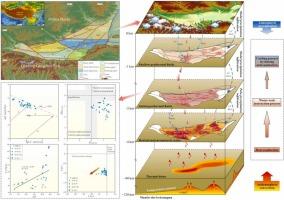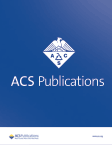中国渭河盆地高氟地热水的水化学过程和氟富集模式
IF 2.9
Q2 PUBLIC, ENVIRONMENTAL & OCCUPATIONAL HEALTH
引用次数: 0
摘要
中国渭河盆地部分地区蓝田-白河地层深层地热水中氟化物的富集对该地区数百万居民的健康具有潜在危害。我们对渭河盆地 31 口地热井的水样进行了水化学和水文地质分析,旨在确定深层地热流体的分布特征、富集模式、水化学过程和影响地球化学的因素。我们还评估了这些流体中氟离子对健康的潜在危害。结果表明,高氟地热流体广泛分布于渭河盆地的深含水层中。主要的水化学类型有HCO3-Na和SO4⋅HCO3⋅Cl-Na。我们利用流体力学模拟和回归分析表明,地热水中 HCO3- 的比例较高,有利于 Ca2+ 的沉淀和含氟矿物的溶解。高温、碱性环境、阳离子交换反应以及溶解和沉淀过程导致 Ca2+ 耗竭,从而促进氟离子从周围岩石释放到地热流体中。人类健康风险评估显示,地热水对成年男性、成年女性、儿童和婴儿的危害商数(HQ)值为分别为 3.96 - 14.41(中位数 6.55)、3.32 - 12.08(中位数 4.50)、4.63 - 16.84(中位数 5.50)和 7.48 - 27.22(中位数 9.00)。由于生理特点,婴儿最容易受到地下水中高氟化物的影响,而儿童和成年妇女/男子受到氟的潜在健康风险相对较低。因此,在开发深层地热水的过程中,要尽可能防止其混入浅层饮用水。如果浅层水中氟离子含量超标,可能会对当地环境和居民健康造成影响。这些研究结果为有效管理渭河流域及其他类似地区的高氟地下水提供了科学依据。本文章由计算机程序翻译,如有差异,请以英文原文为准。

Hydrochemical processes and fluoride enrichment patterns in high-fluoride geothermal water in the Weihe Basin, China
The enrichment of fluoride in the deep geothermal water of the Lantian – Bahe Formation in parts of the Weihe Basin in China is a potential health hazard for the millions of inhabitants of this region. We conducted hydrochemical and hydrogeological analyses of water samples from 31 geothermal wells in the Weihe Basin, with the aims of determining the distribution characteristics, enrichment patterns, hydrochemical processes, and the factors influencing the geochemistry of deep geothermal fluids. We also evaluated the potential health hazards of fluoride ions in these fluids. Our results show that geothermal fluids with high fluoride content are widely distributed in the deep aquifers of the Weihe Basin. The principal hydrochemical types are: HCO3–Na and SO4⋅HCO3⋅Cl–Na. We used hydrodynamic simulation and regression analysis to show that the high proportion of HCO3– in the geothermal water facilitates the precipitation of Ca2+ and the dissolution of fluorine-bearing minerals. The high temperature, alkaline environment, cation exchange reactions, and dissolution and precipitation processes lead to Ca2+ depletion, which facilitates the release of fluoride ions from the surrounding rocks into the geothermal fluids. A human health risk assessment shows that the hazard quotient (HQ) values of geothermal water for adult males, adult females, children, and infants are: 3.96 – 14.41 (median 6.55), 3.32 – 12.08 (median 4.50), 4.63 – 16.84 (median 5.50), and 7.48 – 27.22 (median 9.00), respectively. Infants are the most susceptible to the effects of high fluoride in groundwater due to their physiological characteristics. while the potential health risks of F− for children and adult women/men are relatively low. Therefore, in the process of developing deep geothermal water, it is necessary to prevent it from mixing into shallow drinking water as much as possible. If the fluoride ion content in the shallow water exceeds the standard, it may have an impact on the local environment and residents' health. These findings provide a scientific foundation for the effective management of high fluoride groundwater in the Weihe Basin and analogous regions elsewhere.
求助全文
通过发布文献求助,成功后即可免费获取论文全文。
去求助
来源期刊

ACS Chemical Health & Safety
PUBLIC, ENVIRONMENTAL & OCCUPATIONAL HEALTH-
CiteScore
3.10
自引率
20.00%
发文量
63
期刊介绍:
The Journal of Chemical Health and Safety focuses on news, information, and ideas relating to issues and advances in chemical health and safety. The Journal of Chemical Health and Safety covers up-to-the minute, in-depth views of safety issues ranging from OSHA and EPA regulations to the safe handling of hazardous waste, from the latest innovations in effective chemical hygiene practices to the courts'' most recent rulings on safety-related lawsuits. The Journal of Chemical Health and Safety presents real-world information that health, safety and environmental professionals and others responsible for the safety of their workplaces can put to use right away, identifying potential and developing safety concerns before they do real harm.
 求助内容:
求助内容: 应助结果提醒方式:
应助结果提醒方式:


